
University of Silesia in Katowice, Poland

Professor Małgorzata Łuszczak
Graphic Artist, Ph.D. in Humanities, Art Professor.
Małgorzata Łuszczak’s intermedia artistic output includes: drawing, graphics, animation, open-air activities and digital media. In her artworks traditional media are mixed with digital print and Augmented Reality (AR).
Małgorzata Łuszczak has been connected with the University of Silesia for 40 years. In 2012 – 2019 she has been the Dean of the Faculty of Art in Cieszyn and member of the University of Silesia Senate in Katowice. She runs the Drawing lab, Concept Art lab and the Diploma courses at the Faculty of Games and Virtual Space Design.
Over the period 2007– 2018 Małgorzata Łuszczak worked as an academic teacher at the University of Ss. Cyril and Methodius in Trnava, Slovakia, at the Faculty of Mass Media Communication. She delivered lectures on corporate identity at the doctoral studies.
Between 1995 and 1999 Łuszczak worked as an Art Design Director for Top Ware, a German company producing video games (e.g. Jack Orlando).
She has been the winner of numerous awards and distinctions for her artistic activities and organizational work, innovative didactics, international cooperation and popularization of art and culture in Silesia.
More information on:
www.malgorzata.luszczak.com
LABORATORY TOPIC:
Mutations of nature – The laboratory studies organic forms in a digital environment. He deals with derivative forms of nature and transfer to the game engine. The goal is to transform forms into an attractive level of the game, in which the player exploiting these new fancy spaces. In the laboratory, the team will generate various types of organic forms using simulation and procedural development tools.Each student as part of the team will perform experiments. He will receive tools with which he will co-create a peculiar environment into the game world. The game type and type will be determined depending on the results. The Laboratory will mainly conduct its work in:
- game engine Unreal Engine 4
- 3D programs:Blender, MeshLab, Houdini, Quixel, Agisoft
- 2D and 2.5D programs: Substance, Photoshop, Ae, Pr
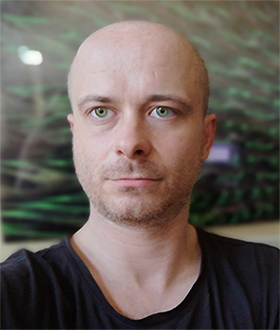
Mentor
Marcin Goldyszewicz
Profile of the Marcin Goldyszewicz – Lecturer at the University of Silesia in Cieszyn. Game artist and developer. He has various skills in visual design with an innovative and experimental approach, which developed over 20 years of work experience. In the gaming industry for 10 years, working as an Artistic Director for 7 years with several completed productions. These productions were games related to the commercial market, as well as independent, made for platforms such as PS4, Xbox, PC, PSP, DS, Wii and mobile. He collaborated with such studios as Bandai Namco, Ubisoft or Bethesda amd was creating titles such as Get Even, Duke Nukem, Settlers, Afterfal, Bruce the Game, AF Reconquest. A graduate of Nicolaus Copernicus University in Toruń. He co-created academic fields related to game design. PhD student and lecturer at the University of Silesia in Katowice.
He’s currently involved in projects exploring a human’s perception as well as forms of nature transformed from physical to digital space.
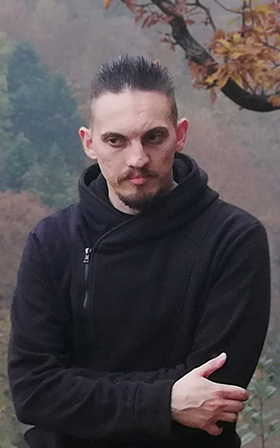
Mentor
Adrian Kuś
Adrian Kuś – He was an avid gamer before he became an artist, and it was his passion for games as a medium to convey emotions and stories that led him to the place he is in now. He is a graduate of University of Silesia, Video Games and Virtual Space Design with specialization at Video Game Graphics. Even during his education he was actively helping with the development of Punk Notion games; two of which, Weakless and The Last Show of Mr. Chardish, have become commercial. Veteran of Game Jams’ such as Global Game Jam, Nordic Game Jam, AmJam, ARP Game(s) Jam, Game Jam Square and LAG, during which he has created over ten projects as a member of Cropseys team, often winning prizes and awards. He is currently working on his personal projects, at the same time supporting other projects as an outsource, and is giving lectures at his Alma Mater. And all of this in breaks between playing more, and more games.
LUCA School of Arts, Belgium
LABORATORY TOPIC : What environment will be the subject of exploration, e.g. living organisms, garden, an imaginary planet etc.
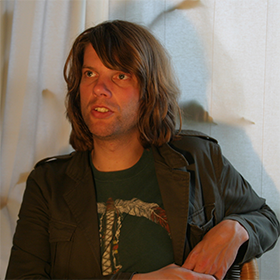
Mentor
prof. Steven Malliet
Lecturer – researcher at Inter-Actions research unit
LUCA School of Arts, campus C-mine
C-mine 5, 3600 Genk, Belgium
biography
What does the LABORATORY do?
Thematic area -what environment will be the subject of exploration, e.g. living organisms, garden, an imaginary planet etc.
The case initiated and promoted by LUCA School or Arts will be linked to the ongoing postdoc research of Dr. Rosanne Van Klaveren. It centers around the concept of human rewilding: a recent trend in art that targets the recovery of our ecosystems, by repositioning mankind in an ecologic connection with other life forms on Earth.
In the context of the postdoc research, already a lot of 360° film footage has been produced, among others in the Northern areas of Finland (Sami territory). The footage enables users/ spectators to become immersed in, and explore a Nature territory that has largely been left untouched by mankind.
Within the proposed case we will use this 360° footage as starting point, and experiment with the creation of game mechanics and dynamics that can intensify the user experience. This can include, but is not restricted to, augmenting the footage with animation effects, creating game rules (e.g. puzzles, quests, action, …), and implementing into contemporary technologies, for instance VR or mixed media. The students will elaborate a game concept that deals with all these aspects. The specific format or genre of the resulting game will be established in a dialogue between the case mentors and the participating students.
Technology and tools
1. Determining in what digital form we plan to work (what engines, 3d editor, 2d, VR, AR) – you can choose freely.
As a starting point, we do not wish to pinpoint the case to once specific technological platform on beforehand. The students should be free to experiment with the format they find most interesting. The result could be a classic 3D-exploration game, but could also be expanded into VR or mixed media formats.
At LUCA campus C-mine, we use the Unity engine to create the game environment and rules, in addition to Blender and Adobe After Effects to create 3D models and postproduction. Students are free to use any software the find the most suitable, in dialogue with the case mentors.
2. Alternatively, a suggestion (if it can be determined) what kind of game we want to implement, e.g. adventure, action, logical etc.
We believe it is an important opportunity of this project that students engage in an inter-cultural dialogue with each other (and the mentors). We do not want to pre-determine the specific type of game that should be made, but we hope this can emerge from the creative dynamics between the participating students.
Optional
The genesis of the outline of the game’s history or game idea, but in a very open form, because in my opinion it is a task for students.
In a rapidly changing world we are facing important social and ecological challenges. We believe it is our responsibility as artists and designers to raise an awareness, and to find ways to use technology to work towards a sustainable future. Within this general rationale we can build on the expertise of Dr. Rosanne Van Klaveren in the territory of 360° production and collaborative design of social experiences.
Expected effect
The result will be a fragment of a working game (e.g. a walking simulator) presented in the form of a film presentation – this is a kind of demo of a working game.
A playable build of the game should be delivered at the end of the academic year. Additionally a playthrough film should be provided that illustrates the game mechnics, animations and use of technology.
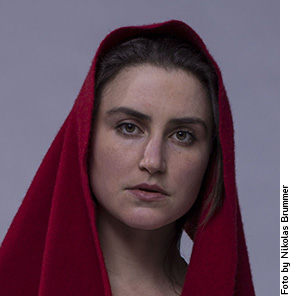
Mentor
Carina Erdmann
Carina Erdmann (* 1990, Cologne DE) is a multimedia artist and PhD researcher at Inter-Actions research unit LUCA School of Arts, based in Berlin and Brussels. With a background in theater and further education in audiovisual media, performance, critical theory and game design at universities in Los Angeles, Berlin, Paris and Amsterdam her artistic practice is marked by a synthesis of different disciplines and perspectives. Her work focuses on collective worldbuilding, critical empathy and enabling structures presented in video games, role-plays, immersive exhibitions, videos, performances and workshops. In her research she develops and assesses Remote Live Game Play and hybridization of online gaming and performance. Her work has been exhibited in international exhibitions and has been awarded with residencies and grants. Carina is a co-founder of 0ct0p0s, a research platform for collective and interactive narration. She has worked for different art institutions on the development of participatory artist workshops, interactive live broadcasts and simulation games.
University of Ostrava, Czech Republic
LABORATORY TOPIC: Spiritual Laboratory – Inner space of a man as a Laboratory.
Human soul as a field for experiments, research and transformation.
Shamanistic, alchemical or other universe as a way inside and as a platform for a game.
Software: Photoshop, Illustrator, Flash, After Effects, Premiere, 3d Max

Mentor
prof. Marek Sibinsky
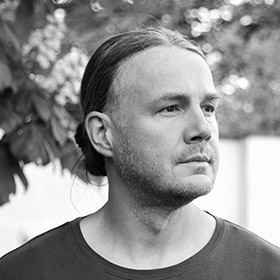
Mentor
Jan Drozd
Marek Sibinský – Lecturer at the University of Ostrava, Czech Republic.
In 1997 he got the Master’s degree at the Pedagogical Faculty of the University of Ostrava (Dpt. of Fine Arts – Studio of Free and Applied Graphics of Prof. Eduard Ovčáček). Since 1998 he has been teaching at the Department. In 2006 he finished his doctoral studies and in 2015 he completed his habilitation at the Silesian University in Katowice, branch in Cieszyn, Faculty of Art, Institute of Art. In his artistic activities he concentrates on graphics, painting and experimental approaches in graphics. Marek Sibinský elaborates his topics in thematic cycles. Beside the actual reflection of the present days, as well as his interest in the newest print technologies. First of all it is the technique of silkscreen and possibilities of digital print, and then the experimental technique using various forms of reprint. The author keeps developing them and probes other alternatives of their solution which emerge during the process of creation. Marek Sibinský is thinking intensively about the problem of communication among people with the help of new media. Along with the topics of his works, he tries to articulate the sense of varied kinds of information of different quality level, which attack us from all sides and various territories in the daily routine.
Jan Drozd – Lecturer at the University of Ostrava, Czech
Republic.
The main areas of activity are painting, graphics and animation. He participates in the Digital center project of 2d and 3d technology at the University of Ostrava. He cooperates with the Silesian University in Cieszyn (specialization in Graphics in a Virtual Environment, LAG project). He is interested in the psychological side of artistic creation, mapping the inner space of the artist – creator, research and processing of psychic phenomena (dreams, altered states of consciousness). He has participated in many exhibitions in the Czech Republic and abroad and has implemented many projects, especially in the field of animation. He actively creates music – playing in band Tamala.
SCHOOL OF ART AT NORTHERN ILLINOIS UNIVERSITY, UNITED STATES
LABORATORY TOPIC: Cryptography. Signs and secrets.
The laboratory will encode and decode information exchanged with a mysterious extraterrestrial civilization.
The game is a logic game.Technology: use of 2D or 3D graphics and any game engine.

Mentor
Aleksandra Giza,
Professor of Visual Communication program in the School of Art at Northern Illinois University, United States
Aleksandra Giza, PhD is an associate Professor of Visual Communication program in the School of Art at Northern Illinois University and a Professor of University of Opole. She graduated from the Fine Arts Academy in Cracow, Katowice Branch, Poland, where she also started her academic career in 1989. After being awarded the UNESCO-Ashberg Grant in 1996, she participated in the design research program at Jan Van Eyck Akademie in Maastricht, The Netherlands. She relocated to the United States in 1998 where she continues to teach undergraduate and graduate design at the School of Art and Design, Northern Illinois University.
In her research she focuses on cultural and historical conditions influencing contemporary design. Another trend of her interests is unconventional typography. Aleksandra Giza designs posters and books, performs curatorial functions, and writes about design. She lectures at schools in Europe, America and Asia. Since 2005, she has been running foreign programs with focus/profile on design for Northern Illinois University students.

Mentor
Amanda VanValkenburg
Amanda VanValkenburg is an Assistant Professor at Northern Illinois University and is the Time Arts Area Coordinator. She is a visual artist using a combination of traditional and digital techniques. Her personal art practice and teaching experience works between 3D animation and modeling, using game engines to design interactive environments, as well as using sound and video editing software to create moving image work. Her work has been exhibited in the MCA, Elmhurst Museum, Mana Contemporary, Woman Made Gallery, 6018 North Gallery, LeRoy Neiman Center, and screened at the Gene Siskel Theater, Nightingale Cinema, Links Hall, Filmfront, and the Chicago Digital Media Festival. She has also completed residencies at Ox-Bow School of Art, High Concept Labs at Mana Contemporary in Chicago, and Ragdale.
Harz University of Applied Science, Wernigerode, Germany
LABORATORY TOPIC: Simplicity of complexity
The concept of emergence describes how complex structures and behaviours can arise from a system of seemingly simple rules and components, or even chaos. From the self-organizing behaviour of a beehive to the similar but endlessly diverse structures of snow crystals and to the human mind itself: Emergent behaviour plays a major role in many areas, such as nature, social life, systems thinking or artificial intelligence. It is not governed by a central instance but develops rather spontaneously when the parts of a system interact with each other. But the beauty and complexity that appears when emergence happens is greater than its parts and cannot be fully predicted.
Games like 'Go’ and 'Tetris’ achieve endless hours of deep emergent gameplay from simple rules, while 'Dungeons & Dragons’ defined a system of rules for the collaborative creation of ever-evolving emergent stories.
In this Laboratorium we will experiment with the molecular parts of games to discover emergent gameplay, interactions, narrations and visual structures. An approach of reduction and minimalism that can lead to complexity nevertheless.
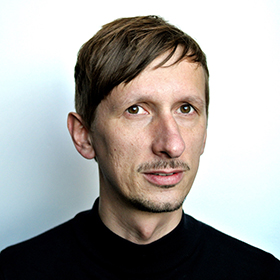
Mentor
prof. Dominik Wilhelm,
Professor of Media Informatics/Game Design/Applied Games at Harz University of Applied Sciences, Germany.
Dominik Wilhelm has been engaged in designing has been engaged in designing user interfaces, experimental games and interactions since the early 2000s. He worked as a designer and art director for several european digital-media agencies, lived in Japan for a few years to design videogames for Masaya Matsuura’s company 'NanaOn-Sha Co.’ and as Lead UI Designer at Suda51’s studio 'Grasshopper Manufacture Inc.’ and is consulting companies on how to implement gameful strategies into their products and organizations.
Since 2013, he teaches game design, game culture and user experience design for games. In 2018 his students have received the 'Newcomer Award’ of the ‘German Video Games Award’ awarded by the Federal Ministry of Transport and Digital Infrastructure of Germany. His recent research was on applied games for training sustainable thinking and games for intercultural training. He is a founding member of the 'German Games Industry Association’ and curator of the annual conference ADD ON ( addon.hs-harz.de ) which acts as a knowledge and networking hub for game design students, young academics and industry professionals. He is currently working as a user experience consultant for a next-gen console game (PS5, Xbox X) by Bandai-Namco.
Having lived in many corners of the planet (Tokyo, NYC, Melbourne etc.), he has a strong international perspective and always strives to connect people and ideas around the globe.
Games worked on include Shadows of the Damned (PS3, Xbox 360), No More Heroes 2: Desperate Struggle (Wii), Guild-01: Kaiho Shojo (3DS), Lollipop Chainsaw (PS3, Xbox 360) and Killer is Dead (PS3, Xbox 360) among others.
Universidad Autónoma de Puebla, Mexico
LABORATORY TOPIC: Mask of truth
Main idea
Beyond the truth, many masks of reality confuse the conscience of a man who must gradually recover his memory and health. Introspection and its sense of what is just and unjust are its only tools to regain its place in the world. With a great responsibility on his back and in a luxury hospital, safe from the misery that floods the world, he must return to recover his ability to live with others, to know who he is and fulfill his duty as a prominent scientist in a world uneven on the verge of extinction.
Argument
„In the darkest moments, the faint human glow is more beautiful”
Dr. Paracelsus Roegen (2040-2087)
Year 2084. Doctor Paracelsus Roegen has been in a coma for 3 years as a VIP patient who has lost his memory. Too weak to breathe, stays connected to artificial respiration. His only contact with reality is Dana Morgan, a terrific nurse and George McLow, an always bad mood stretcher-bearer alf human half machine. Dr. Roegen should use his cold and brilliant analytical thinking to regain his memory meanwhile Dana explains him that humanity is on the brink of extinction because an uncontrolled pandemic. He knows that there is a hope hidden in some part of his chaotic mind. His life, like that of all survivors, is monitored by T.R.U.T.H. (Technological Research Underneath True Health) trough summer modern mouth- covers. TRUTH is the corporation that pays for his luxurious recovery. Dr. Roegen decides that the secret that can give hope to the world must be transmitted without falling into the hands of the corporation. He will have to find a way to escape the fortress-hospital and gather the materials to develop the antidote that can give humanity a second chance. But first, he must remember the truth.
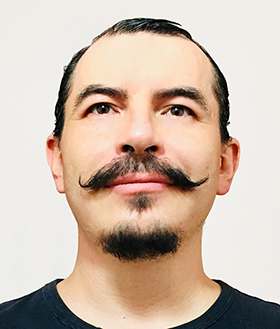
Mentor
prof. Julio Broca
Julio Broca is a graphic designer and sociologist specialist in Creative Process. He has been a visiting professor at different universities in the United States and Europe. His work has been exhibited in the main biennial posters in Latin America and Europe. Author of the book Disoñando Utopías. Co-founder of the Latin American Graphics Siglos XX y XXI project. He directs the Design Department at the Institute of Social Sciences and Humanities of the Benemérita Universidad Autónoma de Puebla.
TOKYO UNIVERSITY OF TECHNOLOGY, SCHOOL OF MEDIA SCIENCE
LABORATORY TOPIC: Enhancement of user experience and sustainable game development
The experience through games is becoming more diverse.
The application of VR and AR to games is the best example, and the quality of the user experience has improved dramatically. Interactions between the game world and the user have changed as well. There are many changes from traditional digital buttons to analog inputs, gyros, and gestures. Aiming for higher levels of technology for interacting with the cyber world is one of our themes.
In addition, the time and cost of development of sophisticated games has become enormous. The cost and time required to develop a game for a diverse range of users is enormous, and development is becoming increasingly difficult. It is also important to explore various development techniques for sustainable game development.
Enhancement of Human – Computer Interaction
Procedural Production of Many Types of Asset
Enhancement of Various Game AI
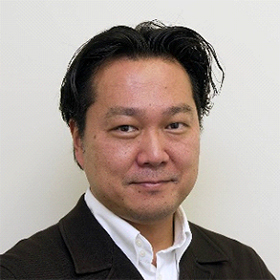
Mentor
Prof. Mikami Koji
Mikami Koji
Graduated in 1995 from Faculty of Environmental Information, Keio University. He worked Nissho Iwai Corporation and MK Company as a producer. In 1998, together with Mitsuru Kaneko, he established “Creative Lab” at the Katayanagi Advanced Research Lab of Tokyo University of Technology (TUT), where research on next generation visual content production and the digitization of the animation production process is conducted. He is also one of the pioneer of a game education in University and received the IPSJ Excellent Educator Award in 2012. He is also a member of committee of a lot of governmental project for Game, Anime and Feature film industry. He is working as a liaison between Academic and Industry. Currently, he is a fulltime professor at the School of Media Science, TUT.
Education
- 1995 Bachelor of Environmental Information from Keio University
- 2001 Master of Media and Governance from Keio University
- 2008 Ph.D (Media and Governance ) from Keio University
Activity of Society
- 2016 – 2018 Chair of the Society for Art and Science
- 2013 – present Board member of the Digital Game Research Association in Japan
- 2011 – 2015 Board member of the Society for Art and Science
- 2011 – present Committee member of SIG on Digital Contents Creation of Information Processing Society of Japan
- 2011 – present Committee member of CEDEC(Computer Entertainment Developpers Conference)
- 2005 – 2007 Cordinator of JETRO (Local to Local Project)
- 1998 – present Reviewer: Siggraph Asia, NICOGRAPH International, International Workshop on Image Electronics and Visual Computing etc

Mentor
prof. Kunio Kondo
Emeritus Professor KONDO Kunio
Ph.D. in Eng.
Kunio KONDO is an Emeritus Professor in the School of Media Science, Tokyo University of Technology. He received his Ph.D. in Eng from the University of Tokyo in 1988 and a Bachelor from Nagoya Institute of Technology in 1978. He was an Associate professor of Department of Information and Computer Sciences, Saitama University from 1989 to 2007, Lecturer of Tokyo Polytechnic University from 1988 to 1989 and Technical staff of Nagoya University from 1973 to 1988, a part-time lecturer at Tokyo University from 1991 to 2007, Aichi Prefectural University of Fine arts and Music from 1989 to 1999, Kyushu Institute of Design from 2002 to 2010, Visiting professor of Management and Science University (Malaysia) from 2014. In 2020, he is a visiting professor at Toho University (Japan), Brawijaya University (Indonesia) 2020. Also, he is the KMUTT curriculum committee member of the Digital Technology Program from 2020 to 2023.
His research interests are computer graphics, animation, games, and interactive modeling. He received the IPSJ the Anniversary Best Paper Award in 1985, the JSGS Research Award in 1985, and the JSGS Best Paper Award in 2011, The Yayasan MSU-ADADA Award of the Lifetime Achievement in Digital Art and Design in 2019. He is a Fellow of IPSJ (Information Processing Society of Japan) and Fellow of IIEEJ (The Institute of Image Electronics Engineers of Japan).
He is the president of ADADA International and ADADA Japan. He was former President of The Institute of Image Electronics Engineers of Japan, former President of The Society for Art and Science, former Vice President of Japan Society of Graphic Science, and Chair of SIG on Computer Graphics and CAD of Information Processing Society of Japan, Board member of Asia Digital Art and Design Association.